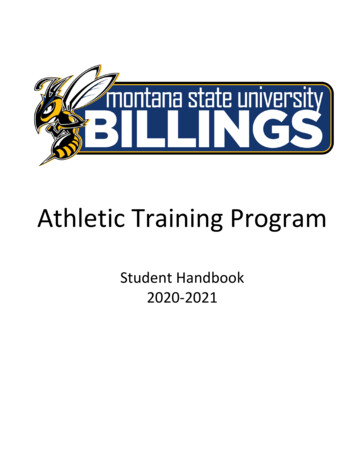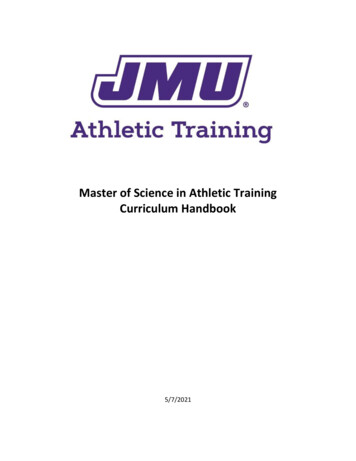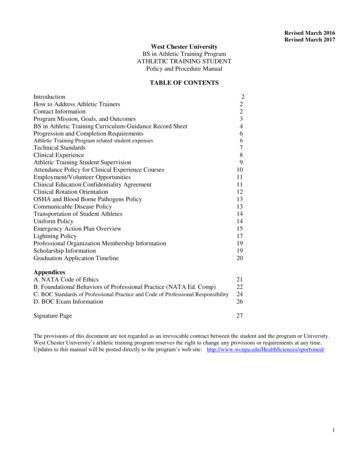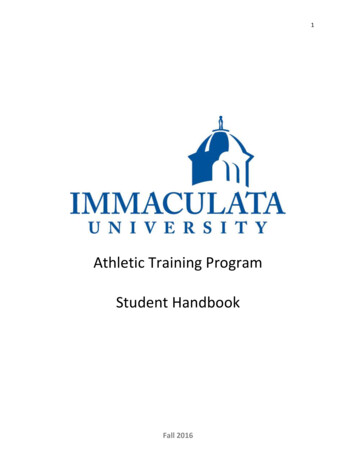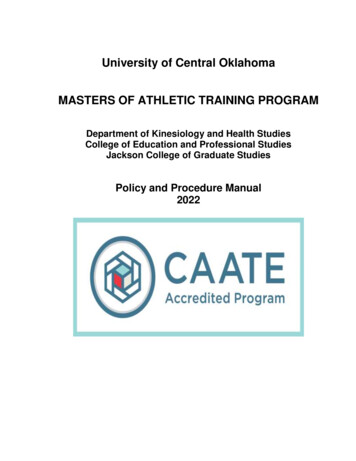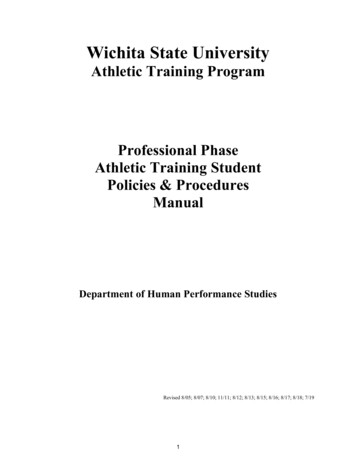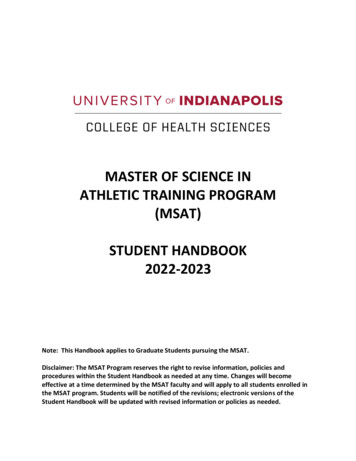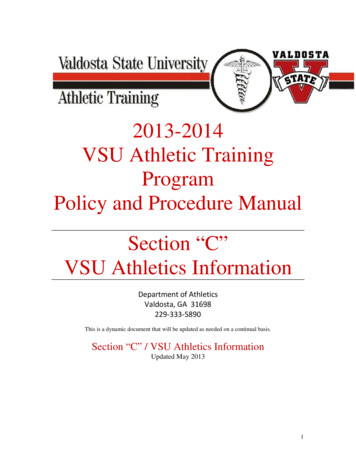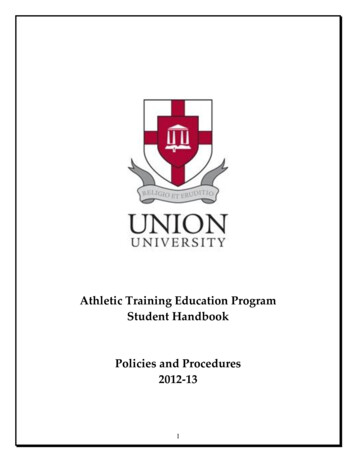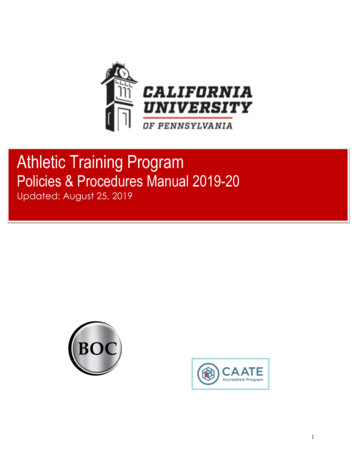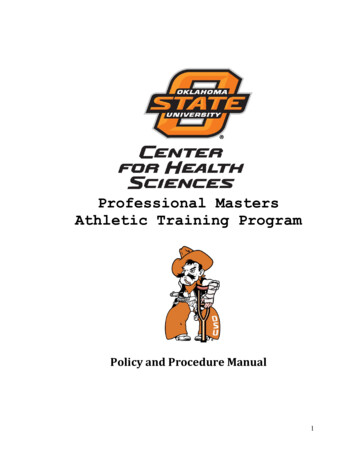
Transcription
Professional MastersAthletic Training ProgramPolicy and Procedure Manual1
Table of ContentsPage 2ATP Faculty .4Welcome .5An Athletic Trainer’s Creed.6Overview of AT Profession .7Code of Ethics .8BOC Practice Standards .8Curriculum .11Mission Statement .11Goals .11Admission Criteria .12Extra Curricular Activities .13Technical Standards .13Physical Capabilities Assessment .14Academic Progression (2 year plan) .14Clinical Experience .15Practicum Courses .19Responsibilities of ATS / PRECEPTOR .19Clinical Experience Contract .20Documentation of Clinical Experience .20Clinical Hours Minimum and Maximum .21Clinical Rotation Assessment .21Remuneration Policy.21Sample Copy – Clinical Experience Contract .22Legal Issues .23Academic Integrity.23Absence from Academic Responsibilities .23Infraction Policy.24Disciplinary Action / Reporting Violations .24Official Procedures for Reporting Violations .242
Behavior Policies .25Examples of Infractions .27Grievance Policy .27Appeal Process .27Retention Policy .28Vacation Periods .28Adverse Weather .28Outside Employment .28Sample Copy – Incident Report .29Sample Copy – Incident Report Follow Up .30Sample Copy – Non Cognitive Grade Form .31General Guidelines.32Attitudes and Values .32Attire .32Name Tags .34Appearance .34Personal Electronic Devices .34Confidentiality .35Sexual Harassment .35Gambling.35Hazardous Waste & Infection Control Policy .35Reporting an Incident .35Universal Body Substance Isolation Policy / Procedure.36Hepatitis B Vaccination .40Professional Organizations & Memberships .41Scholarships .41Program Costs .41Student Forms .42Emergency Action Plan . 43Communicable Disease Policy .44Retention Policy .45Absence Request form .46Technical Standards .47Competency Criteria .48Hepatitis B .49Confidentiality .50Signature Page .513
ATP FacultyRevised 8/2021Jennifer Volberding, PhD, ATC, LAT, Program DirectorMatthew O’Brien, Ph.D., ATC, LAT, Clinical Education CoordinatorAric Warren, EdD, ATC, LAT, CES, CSCSJaclyn Arduini MS, LAT, ATC, CAT (C), CES, Doctoral Graduate Teaching AssistantKimberly Barron, ATC, DO, Medical Director4
Oklahoma State University Athletic TrainingWelcome to the OSU Athletic Training Program. Congratulations on being accepted into aprogram that has a strong history of producing successful athletic trainers. Our faculty and staffare excited to work with quality students like yourself in the process of your development of afuture certified athletic trainer.Athletic training is a very rewarding and exciting profession which demands dedication and hardwork without much public credit. As an Athletic Training Student, you will take part in theprevention, assessment, treatment, and rehabilitation of injuries in a variety of patients at variousclinical settings. We challenge you to learn as much as you can each day whether it be in a classor while are at a clinical assignment. In order for our program to operate efficiently, an ATSmust work diligently, and assume all responsibilities that are delegated to them in a mature andresponsible fashion. ATS’s must work together and be part of a team. This is an important stepin learning to function as part of an integral member of a health care team.It is extremely important to familiarize yourself with the contents of this manual. This manualprovides answers to many of your questions and describes the policies and procedures of ourprogram in detail. Know this manual inside and out.We believe the best method of learning is to combine the knowledge from your classes andclinical experiences in the learning environment. The opportunities to apply classroomknowledge at your clinical site are there, you just need to take advantage of them. Doing so willenhance your learning process tremendously and make your experience very positive andenjoyable. Like this profession, the program requires many hours of both classroom and clinicaltime. In order to succeed as a student, as well as in our program, you must learn to budget yourtime and prioritize your commitments and activities.The AT major at OSU in unlike any other. You will get to know your fellow classmates betterthan any area of study on campus. Take advantage of this and treasure these moments together.This should be the best time of your life, so enjoy it and have fun!!Go Pokes!!Jennifer Volberding, PhD, ATCAthletic Training Program DirectorMatthew O’Brien, PhD, ATCClinical Education CoordinatorAric Warren EdD, ATC5
An Athletic Trainer’s CreedWe accept responsibility for athletes,Who come to double days overweight and out of shape,Who want you to lie about their height stats,Who can never find their practice uniform.And we accept responsibility for those,Who forget to brush their hair for team pictures,Who run slower than everyone else,Who are from places we wouldn’t be caught dead in,Who have never been away from home.We accept responsibility for athletes,Who bring in a week’s worth of ace bandages,Who hug us when they are soaked with sweat and blood.We accept responsibility for those,Who will always sit on the bench,Who will forever play on the “scrub” team,Who never get their uniforms dirty,which won’t ever see their name or picture in the paper,whose names people skim over in the team program,Whose skills are lousy, but whose hearts are strong.We accept responsibility for athletes,Whose financial aid doesn’t come in until February,Who are declared ineligible before they play their first game,Who beg for aspirin, but forget to take it,Who are always late for treatments,Who lie about taking showers after practice,Who say they have night class just so they can get to dinner on time,Who squirm when they’ve got to get dressed beyond sweats,Whose tears we sometimes laugh at, and whose smiles make us cry.And we accept responsibility for those,Whose feet always smell,Who get angry for having to sit out practice,Who hate doctors,Whose egos are bigger than their bodies,Who never want to be carried off the court,Who always want to keep playing, even when their bodies no longer can.We accept responsibility for athletes who want to be the greatest,And for those who truly will be,For those who never give up or quit, for those who play hard, no matter what the score.God grant us the courage to accept these athletes,No matter what size, shape, skill, personality.God grant us the strength to do our best,Care for them when they are hurt,Encourage them when they are down,Understand them when they are defeated,Celebrate with them when they are victorious.6
ATHLETIC TRAINING PROGRAMOklahoma State UniversityOverview of the ProfessionTHE CERTIFIED ATHLETIC TRAINERThe Athletic Trainer (AT) is a highly educated and skilled allied health care professional specializing in athletichealth care of physically active people. In cooperation with physicians and other allied health personnel, the AthleticTrainer functions as an integral member of the health care team in secondary schools, colleges and universities,sports medicine clinics, industrial settings, professional sports programs and other health care settings.EducationCurrently, Athletic Trainers must possess, at minimum, a bachelor’s degree from an Accredited Athletic TrainingProgram (ATP). As of 2022, all ATP’s must be a Master’s degree granting program. The Commission onAccreditation of Athletic Training Education (CAATE) is the recognized accrediting body for our Athletic TrainingProgram. The OSU Athletic Training Program received initial accreditation status in the Fall 2006 and currently hasreceived accreditation through 2026. In 2015, the OSU ATP discontinued the undergraduate degree housed in theCollege of Education in Stillwater and created a Masters in Athletic Training housed in the School of Allied Healthat the Center for Health Sciences in Tulsa.Professional training education uses a competency-based approach in both the classroom and clinical settings. Usinga medical-based education model, athletic training students are educated to provide comprehensive patient care infive domains of clinical practice: prevention; clinical evaluation and diagnosis; immediate and emergency care;treatment and rehabilitation; and organization and professional health and well-being. The educational requirementsfor CAATE-accredited athletic training programs include acquisition of knowledge, skills and clinical abilities alongwith a broad scope of foundational behaviors of professional practice. Students complete an extensive clinicallearning requirement that is embodied in the clinical integration proficiencies (professional, practice orientedoutcomes) as identified in the Athletic Training Education Competencies .Students must receive formal instruction in the following specific subject matter areas identified in theCompetencies:Evidence-Based PracticeTherapeutic InterventionsPrevention and Health PromotionPsychosocial Strategies and ReferralClinical Examination and DiagnosisHealthcare AdministrationAcute Care of Injury and IllnessProfessional Development and ResponsibilityAccessed ucation-overview”Athletic Training Students alsoparticipate in extensive clinical affiliations with the active population under direct supervision of a BOC CertifiedAthletic Trainer (ATC ) or healthcare provider (aka. Preceptor). These five immersive rotations provide thestudent the opportunity to gain experience with a diverse group of patient populations to prepare them for the widearray of career options available following graduation.CertificationCertified Athletic Trainers have satisfactorily fulfilled the requirements for certification established by the Board ofCertification, Inc. (BOC). BOC certification is recognized by the National Commission for Certifying Agencies andis currently the only accredited certification program for Athletic Trainers. The certification examinationadministered by BOC evaluates a candidate’s knowledge, skills and abilities required for competent performance asan entry level Athletic Trainer. Candidates must complete an accredited Athletic Training Program and pass theBOC certification examination, at which time the BOC with designate the credentials “ATC ” to the successfulcandidate.Students become eligible for BOC certification through an athletic training degree program (Bachelor’s orprofessional Master’s) accredited by the Commission on Accreditation of Athletic Training Education (CAATE).Students engage in rigorous classroom study and clinical education in a variety of practice settings such as high7
schools, colleges/universities, hospitals, emergency rooms, physician offices and healthcare clinics over the courseof the degree program. Students enrolled in their final semester are eligible to apply for the BOC exam.For more information visit the National Athletic Trainers’ Association at www.nata.org and the Board ofCertification, Inc. at www.bocatc.org.NATA CODE OF ETHICSThe Code of Ethics of the National Athletic Trainers’ Association has been written to make the membership awareof the principles of ethical behavior that should be followed in the practice of Athletic Training. The primary goal ofthe Code is to assure the highest quality of health care administered. The Code presents standards of behavior thatall members should strive to achieve. The principles cannot be expected to cover all specific situations that may beencountered by the practicing Athletic Trainer, but should be considered representative of the spirit with whichAthletic Trainers should make decisions. The principles are written generally and the circumstances of a situationwill determine the interpretation and application of a given principle and of the Code as a whole. Whenever there isa conflict between the Code and legality, the laws prevail. The guidelines set forth in this Code are subject tocontinual review and revision as the Athletic Training profession develops and changes.Principle 1: Members shall respect the rights, welfare and dignity of all individuals.Principle 2: Members shall comply with the laws and regulations governing the practice of Athletic Training.Principle 3: Members shall maintain and promote high standards in their provision of services.Principle 4: Members shall not engage in conduct that could be construed as a conflict of interest or that reflects negatively on theprofession.For a complete copy of the ethics and for information reporting a violation of ethics, visit the NATA web page.http://www.nata.org/codeofethics/code of ethics.pdfBOC Practice StandardsI. Practice StandardsPreambleThe Practice Standards (Standards) establish essential practice expectations for all athletic trainers. Compliance withthe Standards is mandatory.The Standards are intended to: assist the public in understanding what to expect from an athletic trainerassist the athletic trainer in evaluating the quality of patient careassist the athletic trainer in understanding the duties and obligations imposed by virtue of holding the ATCcredentialThe Standards are NOT intended to: prescribe servicesprovide step-by-step proceduresensure specific patient outcomesThe BOC does not express an opinion on the competence or warrant job performance of credential holders;however, every athletic trainer and applicant must agree to comply with the Standards at all times.Standard 1: DirectionThe athletic trainer renders service or treatment under the direction of a physician.Standard 2: PreventionThe athletic trainer understands and uses preventive measures to ensure the highest quality of care for every patient.Standard 3: Immediate CareThe athletic trainer provides standard immediate care procedures used in emergency situations, independent ofsetting.8
Standard 4: Clinical Evaluation and DiagnosisPrior to treatment, the athletic trainer assesses the patient’s level of function. The patient’s input is considered anintegral part of the initial assessment. The athletic trainer follows standardized clinical practice in the area ofdiagnostic reasoning and medical decision making.Standard 5: Treatment, Rehabilitation and ReconditioningIn development of a treatment program, the athletic trainer determines appropriate treatment, rehabilitation and/orreconditioning strategies. Treatment program objectives include long and short-term goals and an appraisal of thosewhich the patient can realistically be expected to achieve from the program. Assessment measures to determineeffectiveness of the program are incorporated into the program.Standard 6: Program DiscontinuationThe athletic trainer, with collaboration of the physician, recommends discontinuation of the athletic training servicewhen the patient has received optimal benefit of the program. The athletic trainer, at the time of discontinuation,notes the final assessment of the patient’s status.Standard 7: Organization & AdministrationAll services are documented in writing by the athletic trainer and are part of the patient’s permanent records. Theathletic trainer accepts responsibility for recording details of the patient’s health status.II. Code of Professional ResponsibilityPreambleThe Code of Professional Responsibility (Code) mandates that BOC credential holders and applicants act in aprofessionally responsible manner in all athletic training services and activities. The BOC requires all athletictrainers and applicants to comply with the Code. The BOC may discipline, revoke or take other action withregard to the application or certification of an individual that does not adhere to the Code. The ProfessionalPractice and Discipline Guidelines & Procedures may be accessed via the BOC website, www.bocAT.org.Code 1: Patient ResponsibilityThe BOC certified athletic trainer or applicant:1.1 Renders quality patient care regardless of the patient’s race, religion, age, sex, nationality, disability,social, economic status, or any other characteristic protected by law.1.2 Protects the patient from harm, acts always in the patient’s best interests, and is an advocate for thepatient’s welfare.1.3 Takes appropriate action to protect patients from athletic trainers, other healthcare providers or athletictraining students who are incompetent, impaired, or engaged in illegal or unethical practice.1.4 Maintains the confidentiality of patient information in accordance with applicable law.1.5 Communicates clearly and truthfully with patients and other persons involved in the patient’s program,including, but not limited to, appropriate discussion of assessment results, program plans andprogress.1.6 Respects and safeguards his or her relationship of trust and confidence with the patient and does notexploit his or her relationship with the patient for personal or financial gain.1.7 Exercises reasonable care, skill and judgment in all professional work.Code 2: CompetencyThe BOC certified athletic trainer or applicant:2.1 Engages in lifelong, professional and continuing educational activities.2.2 Participates in continuous quality improvement activities.2.3 Complies with the most current BOC recertification policies and requirements.Code 3: Professional ResponsibilityThe BOC certified athletic trainer or applicant:3.1 Practices in accordance with the most current BOC Practice Standards.3.2 Knows and complies with applicable local, state and/or federal rules, requirements, regulations and/orlaws related to the practice of athletic training.3.3 Collaborates and cooperates with other healthcare providers involved in a patient’s care.3.4 Respects the expertise and responsibility of all healthcare providers involved in a patient’s care.3.5 Reports any suspected or known violation of a rule, requirement, regulation or law by him/herselfand/or by another athletic trainer that is related to the practice of athletic training, public health,patient care or education.3.6 Reports any criminal convictions (with the exception of misdemeanor traffic offenses or trafficordinance violations that do not involve the use of alcohol or drugs) and/or professional suspension,9
discipline or sanction received by him/herself or by another athletic trainer that is related to athletictraining, public health, patient care or education.3.7 Complies with all BOC exam eligibility requirements and ensures that any information provided to theBOC in connection with any certification application is accurate and truthful.3.8 Does not, without proper authority, possess, use, copy, access, distribute, or discuss certificationexaminations, score reports, answer sheets, certificates, certificant or applicant files, documents orother materials.3.9 Is candid, responsible and truthful in making any statement to the BOC, and in making any statement inconnection with athletic training to the public.3.10 Complies with all confidentiality and disclosure requirements of the BOC.3.11 Does not take any action that leads, or may lead, to the conviction, plea of guilty or plea of nolocontendere (no contest) to any felony, or to a misdemeanor related to public health, patient care,athletics or education. This includes, but is not limited to: rape; sexual abuse of a child or patient;actual or threatened use of a weapon of violence; the prohibited sale or distribution of controlledsubstance, or its possession with the intent to distribute; or the use of the position of an athletictrainer to improperly influence the outcome or score of an athletic contest or event or in connectionwith any gambling activity.3.12 Cooperates with BOC investigations into alleged illegal or unethical activities. This includes but is notlimited to, providing factual and non-misleading information and responding to requests forinformation in a timely fashion.3.13 Does not endorse or advertise products or services with the use of, or by reference to, the BOC namewithout proper authorization.Code 4: ResearchThe BOC certified athletic trainer or applicant who engages in research:4.1 Conducts research according to accepted ethical research and reporting standards established by publiclaw, institutional procedures and/or the health professions.4.2 Protects the rights and well being of research subjects.4.3 Conducts research activities with the goal of improving practice, education and public policy relative tothe health needs of diverse populations, the health workforce, the organization and administration ofhealth systems, and healthcare delivery.Code 5: Social ResponsibilityThe BOC certified athletic trainer or applicant:5.1 Uses professional skills and knowledge to positively impact the community.Code 6: Business PracticesThe BOC certified athletic trainer or applicant:6.1 Refrains from deceptive or fraudulent business practices.6.2 Maintains adequate and customary professional liability urces/boc standards of professional practice 1401bf.pdf10
OSU Athletic Training CurriculumCenter for Health SciencesSchool: Allied HealthDepartment: Athletic TrainingDegree: Master of Athletic TrainingAthletic Training Program MissionPrepare individuals to become highly competent and independent clinicians who will enhance the quality of patienthealth care and advance the profession of athletic training through the application of evidence-based practice andtranslational research. Our MAT program instills critical thinking, problem solving, ethical reasoning abilities andinterpersonal skills promoting lifelong learning and an enrichment in the quality of lives for individuals in diversesettings.GoalsThe charge of the Oklahoma State athletic training curriculum is to provide a comprehensive, multifaceted educationcoupled with a clinical foundation to prepare future health care professionals for a career in athletic training. Theprogram emphasizes evidence-based practice and the application of best practices that can transform health care.Graduates of the program possess an understanding of the research process and recognize the importance ofapplying evidence-based research to clinical practice. Our goals are to prepare graduates to apply a wide variety ofspecific health care skills and knowledge within each of the following domains: Injury/Illness Prevention andWellness Protection; Clinical Evaluation and Diagnosis; Immediate and Emergency Care; Treatment andRehabilitation; Organizational and Professional Health and Well-being.Expected student outcomes1) Apply the common values of the athletic training profession including:a. Privacy of patientsb. Teamed approach to practicec. Legal practiced. Ethical practicee. Advancing knowledgef. Cultural competenceg. Professionalism2) Demonstrate knowledge of the practice of athletic training, to think critically about the practices involved inathletic training, including the ability to integrate knowledge , skill and behavior, and to assume professionalresponsibility, the entry-level certified athletic trainer must possess an understanding of the following in relation tothe practice of Athletic Training:a) Evidence-based practiceb) Prevention and health promotionc) Clinical examination and diagnosisd) Acute care of injuries/illnessese) Therapeutic interventionsf) Psychosocial strategiesg) Healthcare administrationh) Professional development3) Demonstrate mastery of all clinical proficiencies outlined in the most current edition of the Athletic TrainingEducation Competencies4) Be proficient in all domains, tasks, knowledge and skills statements outlined in the mostcurrent Board of Certification Role Delineation Studya) Injury/Illness Prevention and Wellness Protectionb) Clinical Evaluation and Diagnosisc) Immediate and Emergency Care11
d) Treatment and Rehabilitatione) Organizational and Professional Health and Well-beinga) Injury/Illness Prevention and Wellness Protection – Students will learn to identify injury, illness, and riskfactors associated with participation in sport/physical activity and implement all components of acomprehensive wellness protection plan and injury prevention program.b) Clinical Evaluation and Diagnosis - Students will be able to conduct a thorough initial clinical evaluationof injuries and illnesses commonly sustained by the athlete/physically active individual and formulate an initialdiagnosis of the injury and or illness for the primary purposes of administering care or making appropriatereferrals to physicians for further diagnosis and medical treatment.c) Immediate a
Currently, Athletic Trainers must possess, at minimum, a bachelor's degree from an Accredited Athletic Training Program (ATP). As of 2022, all ATP's must be a Master's degree granting program. The Commission on Accreditation of Athletic Training Education (CAATE) is the recognized accrediting body for our Athletic Training Program.
